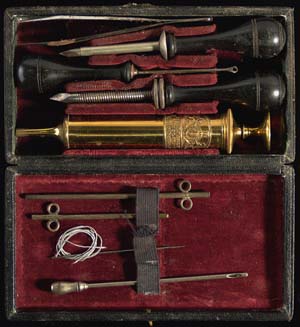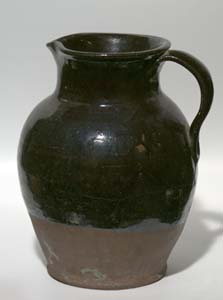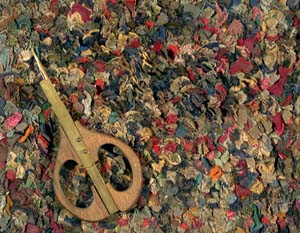|

|
|
Below are some examples from the Museums Collection. Please click for the bigger picture
|
|



|

|
Sheep Shears, Normangill, Crawford, 1900-1950
A set of hand sheep shears, made of iron and with a leather keeper to hold them closed and safe when not in use. Shears like this were once a common tool used by
shepherds. Before the much faster mechanical shears were developed in the early 20th century, all shearing was done by hand – hard work with a flock of several hundred sheep. Today, hand shears survive only for occasional small-scale use, although hand-shearing competitions are sometimes held at agricultural shows.
The handle incorporates a spring that holds the blades apart, and the shears are used against the force of this spring. This helps to overcome the natural tendency of the blades to jam in a heavy, greasy and dirty fleece.
|
|
|

|
Veterinary Tools, for treating Sturdy, 1935-1950
Before motor transport, “calling the vet” was not an option on the hill farms, and shepherds learned to treat many of the routine diseases and injuries in sheep, themselves. They did the best they could, and were often successful.
This boxed set of tools contains all that was required to treat Sturdy, a disease where water collects inside a sheep’s skull.
Made in Edinburgh, an expensive item like this would have been kept in the house or shed until required, and even once a call to the vet became an option, was retained “just in case”.
|
|
|

|
Seed Fiddle, Normangill, Crawford, 1910-1940
Most hill farm land is pasture or rough grazing, although some oats and barley has been grown on the low-lying, fertile, “inbye” land. The amount of land used in this way was never enough to justify the purchase of sowing machinery, and seed was sown by hand, scattered from a basket or by using a “seed fiddle”. The machine has a small hopper for seed, and pulling the “bow” from side to side rotates a circular tray from which the seed is thrown by centrifugal force.
However, the main use for seed fiddles was for re-sowing pasture land with grass seed. After several years of grazing, pasture becomes choked with weeds and must be ploughed. This breaks up the soil, discourages moles, and a few months later new, rich grass will be well established.
|
|
|

|
Dark blue earthenware jug, Glendouran, Crawfordjohn, 1800-1820
This is an example of the type of pottery used by people living in the Southern Uplands. Many villages and small towns at one time made pottery from local clay, for local use. The design is simple and sturdy, and unless dropped or damaged, pieces like this remained in use for generations.
Jugs like this one would have been used in the dairy, and to hold milk for use of the family.
|
|
|

|
Rag Rug, Debog, Glespin, 1930-1950, and Rug Making Tool, Monksfoot, Glespin, 1940-1960
Today, things are thrown away once worn out, and society has forgotten how to “recycle” things for another use. Making rugs from old cloth was once common. Worn-out trousers, blankets and even coats would be cut up into strips, and the whole family would then help to turn them into rugs for the floor. A piece of hessian – sometimes a sack – would be laid out and a special tool used to push and pull the strips of cloth through the loose weave.
Rag rugs only lasted for so many years before they became too worn and dirty. They might then be relegated to the byre, to live yet again as bedding for the working dogs.
|
|
|

|
Hand-operated Washing Machine, Glendorch, Crawfordjohn, 1900-1955
Washing the clothes and linen for a family was hard
work in the 19th century, taking perhaps a whole day each week. Attempts were made to mechanise the process to make it quicker and easier, but nothing made a real difference until the development of electric machines between the wars.
Hand-operated washing machines were not that uncommon, and were undoubtedly more convenient than a tub in the open air. It is made of wood and galvanised iron, and would have been half-filled with soapy hot water before the clothes were added. With the lid closed, the handle was turned to move the paddle inside.
This machine remained in use until the mid 1950’s, in the old shepherd’s cottage at Glendorch.
|
|
|

|
Bag of Marbles, Monksfoot, Glespin, 1900-1930
Marbles, was once a common and popular children’s game, with as many variants on the rules as there were players.
These marbles belonged to the children at Monksfoot in the early years of the 20th century. Most of them are made of fired clay, but some glass marbles more expensive or later in date than the clay ones, have been added. The bag, part of a farm sack cut down and stitched on a machine, also contains a number of “oak apples”. These are very light and are not perfectly round, and it is possible that they were used as “jacks”, at which the other marbles were rolled.
|
|
|